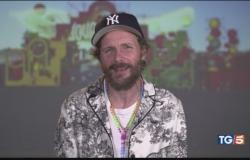15 years of activity and 1800 events to be celebrated with a book of 80 recipes proposed by 78 Italian artists, from Bianco-Valente to Martha of the Angelfrom Iginio De Luca to Luigi Presiccefrom Virginia Zanetti to Eva Sauerfrom Francesco Lauretta to Chiara Mu, Flavio Favelli, Maria Crispal, Tiziana And Isabella Pers And Virgilio Sieni to name a few among the many who responded to the invitation of the Brac Bookshop.
The recipes from Brac’s book in Florence
All strictly vegetarian, like the cuisine of the Brac Bookshop, the recipes tell – with the rules for best preparing the dishes and images – what Italian artists eat. Claudia Passeri offers a Mediterranean salad, Davide Dormino a dish based on red beets, Aryan Ozmaei a peach salad, Stefania Galegati a caponata. Dishes that reveal worlds, journeys and colours, personal stories, sometimes the relationship with the works.
The article continues below
The Brac bookshop in Florence
Founded in Florence in 2009 by the vegetarian chef Sacha Sandri Olmo and by the librarian with a passion for the visual arts Melisa Di Nardothe library has hosted since 2011 Script the art and review words created by the curator Pietro Gaglianò which over time has hosted art critics, authors and many of the artists involved in the book published by Corraini, with texts also by Rosaria Lorusso, Sandro Sangiorgi and Stefano Bartezzaghi. They told us about their experience as a bookshop with kitchen and the publication in this interview.
Interview with Sacha Sandri Olmo and Melisa Di Nardo
How and when was the Brac bookshop born?
S: We had been looking for a space for a long time that would allow us to combine books and food and that would be commensurate with our strengths. That location was ideal because it allowed us to host the two activities without one hiding the other. For many years, the library and dining room shared the same space: a sort of multipurpose room, equipped with a video projector, which was transformed during the day. From a café to a room for press conferences, and then a place for meetings with the authors, a dining room, a tea room… The choice of the address we wanted to give to Brac was the result of our life experiences. I have been a vegetarian since the age of fourteen, it was an ethical choice adopted out of empathy towards other living beings, and I started cooking for myself, also experimenting with more traditional recipes and interpreting them in a vegetarian sense. Then over time it became a job: I have long professional experience in this sector.
And what was the context around you like 15 years ago?
Florence was a city that left very little room for veg alternatives. Melisa’s story is different: she graduated in library science in Urbino and has a love of books in her DNA, along with an innate optimism. In this case cultural interests also played a fundamental role: we are both passionate about contemporary art. Melisa also loves many forms of contemporary expression: theatre, performing arts in general, photography and we both share an interest in music and illustration. Also in this case we took into account what the city had to offer: in 2009 there was no bookshop specializing in contemporary art in Florence. Narrowing down our passions allowed us to better organize the limited spaces we had available. In a short time the courtyard, thanks to the installation of strips of fabric by De Ferrari+ Modesti (evoked on the cover of Corraini’s book), became a distinctive feature of Brac and in 2010 structured meetings with the authors began: here they passed many, in 15 years of existence we have organized 1800 events, but I like to remember the presence of Makkox And Zero limestone when they weren’t yet very famous.
Why celebrate 15 years of life with an artists’ book?
We had been thinking about a book for a few years, perhaps we started thinking about it on the occasion of the celebration of ten years of activity in 2019, but as we had it in mind, as we dreamed it, it was not a quick realization. What was certain is that I wanted a recipe book in which the dishes were not photographed like in traditional recipe books. I’m used to working backstage and I like being behind the scenes: entrusting the artists with the task of interpreting Brac’s dishes, there are 80 recipes, was a way to neutralize the risk of the chef’s ego emerging.
Furthermore, you are not new to this kind of experience…
Well, for example in 2019 we had started the event eight years ago scriptaedited by Pietro Gaglianòwhich then changed skin and places: from a monthly review in bookshops to a festival in institutional places in 2017, and then an event in ARCI circles from 2020. This happy collaboration, which we have always supported, has meant that Brac has become a crossroads of artists: guests of scripta, or spectators of the various initiatives, or simple users or friends and friends of friends. Some at Brac have intervened, leaving permanent works: Luca Pancrazzi, Daniela Comani, Francesco Lauretta, Marta Dell’Angelo, Vittorio Corsini, Margherita Moscardini And Lori Lako. Gaglianò’s experience and curatorial rigor were decisive in involving 78 artists in the creation of the book. The genesis of the volume was quite long but we are happy with the result and the beautiful graphic design of the publisher.
A balance sheet of these 15 years?
M: Brac has grown in recent years in numbers and, from 2021, also in space, and without Sacha’s recipes and his hard work in the kitchen all this would not exist, which is why this book is important. After the lockdown we found a space adjacent to the original premises and this allowed us to double the surfaces and expand the bookshop. The old “multipurpose” room is dedicated exclusively to catering, while the new rooms house books, a cafeteria and a space for meetings.
What do you see in the future of Brac?
The book assortment has expanded with an eye towards other forms of expressiveness. Since 2021, the S/P/Read exhibition dedicated to the translation of the poetic text has begun with the “poet” and performer Rosaria Lo Russo, this year among the candidates for the Strega Poetry Prize. Furthermore, with Vaia Balekis we have broadened our gaze on illustrated books with the Radiosa exhibition, dedicated to those volumes “illuminated” by figures that are not necessarily aimed at children. Finally we produced a series of videos, mini-docu-interviews, entitled Feat, involving important names from the Italian music scene: a project dedicated to music and the skills necessary for the sound of words and notes to become a work and masterpiece, a moment of meeting with authors, composers and artists. Music requires prowess, perseverance and discipline, technique and listening. The hope on this anniversary, in which the second generation is already active in the kitchen, is to be able to pass on to our children a different idea of commerce in a city overwhelmed by overtourism.
Santa Nastro
Artribune is also on Whatsapp. Simply click here to subscribe to the channel and always be updated







